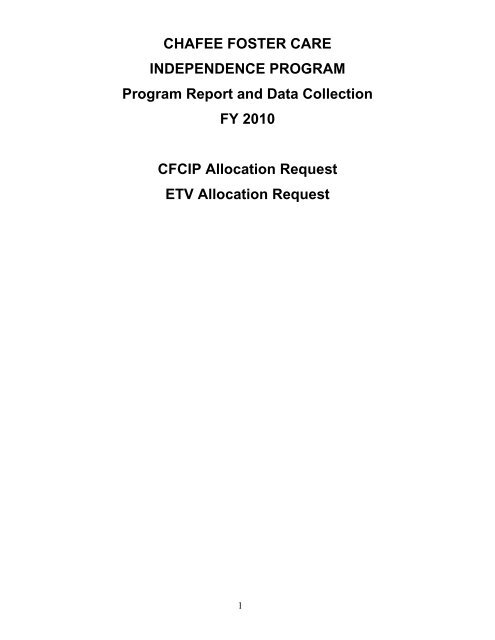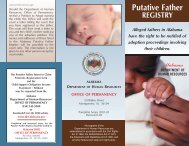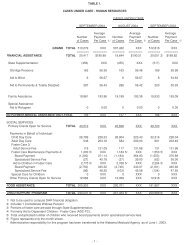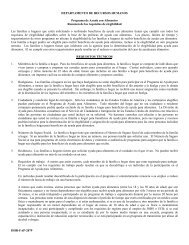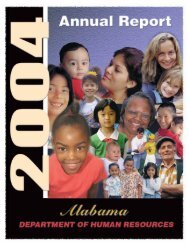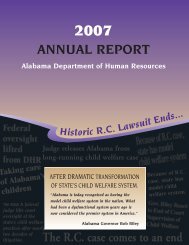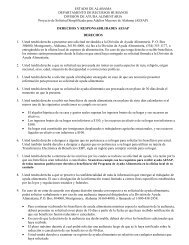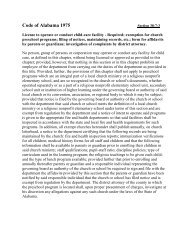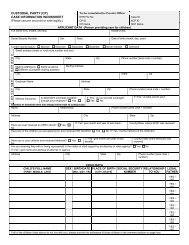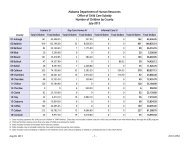CHAFEE FOSTER CARE - Alabama Department of Human Resources
CHAFEE FOSTER CARE - Alabama Department of Human Resources
CHAFEE FOSTER CARE - Alabama Department of Human Resources
Create successful ePaper yourself
Turn your PDF publications into a flip-book with our unique Google optimized e-Paper software.
<strong>CHAFEE</strong> <strong>FOSTER</strong> <strong>CARE</strong><br />
INDEPENDENCE PROGRAM<br />
Program Report and Data Collection<br />
FY 2010<br />
CFCIP Allocation Request<br />
ETV Allocation Request<br />
1
PROGRAM PLAN NARRATIVE<br />
ADMINISTRATION OF PROGRAM:<br />
<strong>Alabama</strong> <strong>Department</strong> <strong>of</strong> <strong>Human</strong> <strong>Resources</strong>, Family Services Division is implementing the Foster Care Independence Act<br />
<strong>of</strong> 1999 by operating a statewide Chafee Foster Care Independence Program. In addition, the Education Training<br />
Voucher Program was implemented in 2004. Direct and indirect services are provided for youth for whom we hold<br />
custody and planning responsibility. <strong>Alabama</strong> <strong>Department</strong> <strong>of</strong> <strong>Human</strong> <strong>Resources</strong>, Family Services Division through the<br />
Office <strong>of</strong> Permanency, administers and supervises the programs and services carried out by the 67 County <strong>Department</strong>s<br />
<strong>of</strong> <strong>Human</strong> <strong>Resources</strong> under the Act. The mission <strong>of</strong> <strong>Alabama</strong>’s Independence Program is to assist <strong>Alabama</strong>’s eligible<br />
foster youth and former foster youth in attaining the skills, education, and character needed to become adults who will<br />
contribute to their community.<br />
<strong>Alabama</strong> currently has 1 coordinator and 1 specialist position dedicated specifically to provide county support and ILP<br />
consultation to county ILP Staff and group homes who are working with foster youth, ages 14 through 20. However,<br />
capacity is being strengthened in all consultants to have a working knowledge <strong>of</strong> the program requirements.<br />
<strong>Alabama</strong>’s State <strong>Department</strong> <strong>of</strong> <strong>Human</strong> <strong>Resources</strong> allows each county to provide their own Foster Care Independent<br />
Living Program. Services are provided through group programs and individual services and several also <strong>of</strong>fer experiential<br />
activities. The programs are to provide services to assist a youth in improving education and career opportunities and to<br />
decrease high-risk activities and the potential for incarceration, non-marital childbirth, dependence, and homelessness.<br />
The Education Training Voucher program is administered through a contract with the Orphan Foundation <strong>of</strong> America. The<br />
funds are used primarily to pay school expenses such as fees, tuition, and books. Each youth’s application requires that<br />
they complete a budget providing information about rent (copy <strong>of</strong> lease agreement is required) and childcare (payment is<br />
made only to a licensed provider). Youth may also request funds to purchase a computer, school sponsored health<br />
insurance, payment <strong>of</strong> outstanding student loans (documentation required), costs related to a disability (eyeglasses,<br />
tutoring, adaptive s<strong>of</strong>tware, etc. and living expenses such as groceries and transportation (not purchase <strong>of</strong> a car).<br />
Information from the schools’ Student Financial Aid Office is required to validate the expense <strong>of</strong> attending the school. No<br />
youth may receive more than $5,000 and the total funds received are not to exceed the cost <strong>of</strong> attendance. Youth must<br />
apply each year to receive funds.<br />
<strong>Alabama</strong> awards each <strong>of</strong> <strong>Alabama</strong>’s 67 counties funds to provide ILP services for their foster teens. When providing<br />
counties with funds for their ILP services, each are reminded that Appropriations law precludes the use <strong>of</strong> Chafee funds to<br />
supplement the $5,000 per-year ceiling for a youth in the Chafee Educational and Training Voucher (ETV) program.<br />
However, General Chafee funds may be used for activities that are outside the scope <strong>of</strong> an institution’s definition <strong>of</strong> “cost<br />
<strong>of</strong> attendance,” and are not covered by the ETV program. Funds are also available for the Poarch Band <strong>of</strong> the Creek<br />
Indian Tribe if they have youth in custody.<br />
SERVING YOUTH OF VARIOUS AGES AND STAGES<br />
Youth receive services at various ages and at various stages <strong>of</strong> achieving independence without regard to their eligibility<br />
for Title IV-E funded foster care. Youth <strong>of</strong> all ages are entitled to receive age-appropriate services, including opportunities<br />
to learn independent living skills and receive unique services as determined by the child and family planning team. Youth<br />
may stay in care by State <strong>of</strong> <strong>Alabama</strong> law until their 21 st birthday. Aftercare assistance is available to youth who leave<br />
care between their 18 th and 21 st birthday in the form <strong>of</strong> financial assistance or services.<br />
Currently the program is managed through the Office <strong>of</strong> Permanency. There is a Program Supervisor serving as the ILP<br />
Coordinator for <strong>Alabama</strong>’s Independent Living Program. The Coordinator has the responsibility <strong>of</strong> building the IL program<br />
at the State level in an effort to ensure youth aging out <strong>of</strong> foster care receive needed services at the local level to increase<br />
their chances <strong>of</strong> success, and to provide Technical assistance and training to County <strong>Department</strong> <strong>of</strong> <strong>Human</strong> <strong>Resources</strong> to<br />
ensure that the Independence Program is uniform throughout the state and still accommodates county modifications.<br />
Recently, a program specialist has been added to the IL Program. However additional staffing dedicated to the IL<br />
program is needed and would provide a broader scope <strong>of</strong> support and program development in supporting older youth in<br />
preparing for adulthood. Due to the staff shortages the Office <strong>of</strong> Permanency is exploring ways to strengthen capacity <strong>of</strong><br />
all consultants to have a working knowledge <strong>of</strong> the Independent Living Services available to youth in care.<br />
There are four components <strong>of</strong> the program that needs to be supported for all youth in care. The components for each<br />
youth are: Promoting a sense <strong>of</strong> control over their future, Promoting a sense <strong>of</strong> competency, Promoting a sense <strong>of</strong><br />
permanency, and Promoting a sense <strong>of</strong> usefulness.<br />
2
CONSULTATION WITH PUBLIC AND PRIVATE ORGANIZATIONS IN DEVELOPING PLAN<br />
Refer to Section titled: Other Ongoing Involvement/Consultation In Planning<br />
DESCRIPTION OF THE CFCIP SERVICES PROVIDED AND ACTIVITIES CONDUCTED<br />
<strong>Alabama</strong>’s State <strong>Department</strong> <strong>of</strong> <strong>Human</strong> <strong>Resources</strong> allows each county to provide their own Foster Care Independence<br />
Program. To support each county the State <strong>Department</strong> awards each <strong>of</strong> <strong>Alabama</strong>'s 67 counties funds to provide direct<br />
independent living services and supports for their foster teens. In addition to funding county programs, the State<br />
<strong>Department</strong> provides training, technical support and resource development services. County <strong>Department</strong>s apply for and<br />
receive funds based on the amount <strong>of</strong> funds available and an annual application in which the County’s Program Plan is<br />
submitted. County programs provide the educational training and financial services necessary for foster teens to acquire<br />
the skills that they will need after they are emancipated from care. Some examples <strong>of</strong> services provided through group<br />
activities include: budgeting, avoiding risky behaviors, basic first aid, cultural diversity, communication, job seeking,<br />
values & responsibilities, public speaking and voting, grief and loss issues, household management, budgeting,<br />
purchasing and insuring a car, safe driving, and teen stress. Experiential activities included: tours <strong>of</strong> college campuses,<br />
shopping trips (money management and social skills), visit to a nursing home, driver’s education, camps, planning menus<br />
and preparing meals, completing job applications, opening bank accounts, and various extracurricular activities.<br />
Residential Child Facilities continue to express interest in developing or enhancing their transitional and independent<br />
living programs. See section on the Office <strong>of</strong> Licensing and Resource Development for additional information. Other<br />
group homes do not have Transitional Living placements but do provide IL services for youth ages 14 - 21. In addition, the<br />
Office <strong>of</strong> Permanency is exploring with the Office <strong>of</strong> Licensing and Resource Development a “Request for a Proposal” to<br />
develop foster homes approved and trained specifically to care for the older youth and provide IL supports beyond that in<br />
a regular foster home.<br />
CRITERIA FOR DETERMINING BENEFITS AND SERVICES<br />
Each youth is involved in the development <strong>of</strong> their individualized service plan (ISP). The ISP is created in partnership with<br />
the youth and family planning team. The ISP identifies the strengths and needs, goals the youth is to work toward to<br />
reach the desired case outcome, and steps to be taken by the youth and family planning team members. The ISP is used<br />
to authorize and deliver services, and to measure progress toward goals necessary to make the transition to selfsufficiency.<br />
An extensive assessment using the Daniel Memorial Program is completed on each teen in the program to<br />
determine the skills the teen has mastered and the skills that the teen needs to acquire. Informal assessments also<br />
provide information about a youth’s needs. The ISP includes results <strong>of</strong> life skill assessments and independent/transitional<br />
living plans. The ISP is updated every six months at a minimum but can be updated as the need for other services and<br />
supports are identified. The youth is given a copy <strong>of</strong> the plan.<br />
INVOLVEMENT OF PUBLIC AND PRIVATE SECTORS IN HELPING ADOLESCENTS ACHIEVE SELF-<br />
SUFFICIENT INDEPENDENCE<br />
As in the past, the Governor has signed Senior Certificates for our graduating high school senior. Information is provided<br />
to youth and staff about community-based employment centers and job training employment opportunities such as those<br />
identified in the Work Force Investment Act <strong>of</strong> 1998 and the <strong>Department</strong> <strong>of</strong> Labor Welfare-to-Work Program.<br />
County <strong>Department</strong>s <strong>of</strong> <strong>Human</strong> <strong>Resources</strong> provide assistance with preparation for job readiness through life skills<br />
development classes. Youth are provided opportunities for career exploration such as guided tours <strong>of</strong> major employers,<br />
attending job fairs and career seminars and by helping with job search support and placement programs. Statewide there<br />
are limited opportunities that are available for job shadowing and apprentice programs.<br />
The <strong>Department</strong> is collaborating with the Workforce Investment Agency and other agencies that serve youth in ETA’s new<br />
strategic vision to serve out-<strong>of</strong>-school and at-risk-youth under the Workforce Investment Act. As stated previously, the<br />
<strong>Department</strong> along with several state agencies, with the <strong>Alabama</strong> <strong>Department</strong> <strong>of</strong> Economic and Community Affairs/Office<br />
<strong>of</strong> Workforce Development as the lead, is part <strong>of</strong> collaboration to serve youth at risk. The Office <strong>of</strong> Permanency has been<br />
involved in a limited manner in the Shared Youth Vision Project. The “Shared Youth Vision,” project is aimed at closing<br />
the gap in services for the neediest youth.<br />
<strong>Alabama</strong> <strong>Department</strong> <strong>of</strong> <strong>Human</strong> <strong>Resources</strong> in the past has provided personal and emotional support through mentors and<br />
the promotion <strong>of</strong> interactions with dedicated adults. Currently the State does not have a mentor program. However, the<br />
<strong>Department</strong> plans to exam what makes a successful mentor program and has been in dialogue with representatives from<br />
the private and faith based sector in an effort to explore this further. This will include identifying the roles and expectation<br />
3
<strong>of</strong> a mentor and the steps to increase successful match between adult mentor and teen. The <strong>Department</strong> believes that<br />
the development <strong>of</strong> a successful Mentor programs will be an important aspect <strong>of</strong> <strong>Alabama</strong>’s ILP.<br />
County <strong>Department</strong>s <strong>of</strong> <strong>Human</strong> <strong>Resources</strong> are encouraged to develop relationships with community-based organizations<br />
to form partnerships for providing mentor programs. Businesses will be encouraged to participate by providing<br />
opportunities for apprenticeships and job shadowing opportunities.<br />
<strong>Alabama</strong> <strong>Department</strong> <strong>of</strong> <strong>Human</strong> <strong>Resources</strong> is continuously working to develop new resources and connecting youth to<br />
existing resources. The needs for older youth in out <strong>of</strong> home care continue to be an area needing focus in the Office <strong>of</strong><br />
Permanency. As a step in the Program Improvement Plan a survey was developed and completed by a sampling <strong>of</strong> older<br />
youth in care, DHR Social Workers and TLP/ILP providers. The results <strong>of</strong> the survey has been shared with youth in care,<br />
DHR Social Workers and providers/caretakers. The feedback the <strong>Department</strong> received provided a clear understanding on<br />
how youth experience the system as well as their needs and how to support these needs. As a result <strong>of</strong> the survey, plans<br />
are being developed that will focused on providing additional supports and resources aimed at youth transitioning<br />
successfully to adulthood. At the state level, the Independent Living Program works closely with the Office <strong>of</strong> Resource<br />
Management to identify and locate resources. Each county <strong>of</strong>fice has an identified Resource Development staff member<br />
who is available to assist in resource development for the county and for individual youth.<br />
AVAILABILITY OF MEDICAID TO YOUTH AGES 18-21<br />
By policy, youth in <strong>Alabama</strong> may remain in care until their 21 st birthday and are eligible for ACFC Medicaid provided all<br />
points <strong>of</strong> eligibility are met. If a youth is discharged from care prior to their 21 st birthday, Medicaid is not available.<br />
SERVICES TO YOUTH AGES 18-20<br />
Youth <strong>of</strong> all ages are entitled to receive age-appropriate services, including opportunities to learn independent living skills<br />
and receive unique services as determined by the child and family planning team. Youth may stay in care by State <strong>of</strong><br />
<strong>Alabama</strong> law until their 21 st birthday. Aftercare assistance is available to youth who leave care between their 18 th and 21 st<br />
birthday in the form <strong>of</strong> financial assistance or services.<br />
<strong>Alabama</strong> provides each youth exiting the foster care system with a one time stipend <strong>of</strong> $1,000.00 for start up cost.<br />
Aftercare financial assistance and support services continue to be available to youth who leave the system prior to their<br />
21 st birthday.<br />
For youth that leave care on or after their 18 th birthday, policy allows for the youth to re-enter foster care if the need arises.<br />
If the youth needs to re-enter foster care or remain in their own home, financial, housing, counseling, employment,<br />
education and other appropriate support and services are also to be provided as needed until the 21 st birthday.<br />
Room and board payments are available for youth who choose to remain in care after their 18 th birthday or for those who<br />
leave care after their 18 th birthday on a case-by-case basis. County staff must make such requests to their State ILP<br />
consultant to ensure no more than 30% <strong>of</strong> the State funds are used for room and board. Room and board funds may be<br />
used to assist with dorm room deposits or to make limited payments on rent when a plan is in place to ensure the youth<br />
will continue to have housing available after the assistance is no longer available.<br />
The <strong>Department</strong> considers all children as “<strong>Alabama</strong>’s Children” without regard to race or culture. The <strong>Department</strong><br />
continues to strengthen services to Indian youth who reside on reservations and need access to benefits and services<br />
under the Chafee Foster Care Independence Program. Families and tribes are included in the ISP for the child when the<br />
<strong>Department</strong> is working with Indian youth living <strong>of</strong>f the reservation and independent living services are being provided.<br />
Indian youth living <strong>of</strong>f the reservation have access to services and benefits under the Chafee Foster Care Independence<br />
Act as would any other child. The <strong>Department</strong> will collaborate with all tribal entities located in <strong>Alabama</strong> to provide<br />
information and obtain input in the support <strong>of</strong> Indian youth and their families. See also Indian Child Welfare (under Item<br />
38) in the 2009 report section and Item 38.2 (The <strong>Department</strong>’s goals in regards to work with the Poarch Creek Indian<br />
Tribe) under the 5 year goals section <strong>of</strong> this report.<br />
EDUCATION AND TRAINING VOUCHERS PROGRAM<br />
The Orphan Foundation <strong>of</strong> America (OFA) will administer the <strong>Alabama</strong> Education and Training Voucher Program (AL<br />
ETV). Below is the program narrative submitted by OFA in response to a Request for Proposal. This narrative details the<br />
plans for <strong>Alabama</strong>’s program. Education Training Voucher funds are available to:<br />
4
• foster youth who are attending post-secondary education in public schools or non-pr<strong>of</strong>it private schools;<br />
• youth who were adopted from foster care after their 16 th birthday;<br />
• youth who aged out <strong>of</strong> foster care on or after their 18 th birthday who have not yet attained the age <strong>of</strong> 21;<br />
• youth must be a citizen or documented alien (eligible for other federal benefits);<br />
• youth may not have more than $10,000 in personal reserves.<br />
The funds will continue to be available to a youth attaining a post-secondary education up to their 23 rd birthday if<br />
assistance through ETV was received during the semester <strong>of</strong> the 21 st birthday and the youth continues to make<br />
satisfactory progress<br />
ETV’s will provide financial support to youth who age out <strong>of</strong> foster care and those who were adopted after age 16 to<br />
attend post-secondary institutions <strong>of</strong> higher learning and vocational/technical training programs.<br />
OFA is a national non-pr<strong>of</strong>it organization with the capacity and expertise to develop the <strong>Alabama</strong> Education and Training<br />
Voucher Program. In consultation with the State it will develop the ETV Program including recruiting applicants for<br />
mentors, designing and processing applications, fiscal management: disbursing scholarship funds, tracking and<br />
monitoring student participation and reporting to the State on a monthly basis.<br />
Intended Outcomes:<br />
The goal <strong>of</strong> the AL ETV Program is to provide the economic and personal supports for eligible youth’s need to attend and<br />
complete post-secondary training and education programs. The program seeks to couple funding with the support and<br />
guidance 18-23 year olds need throughout their post-secondary schooling. The program will build on the services <strong>of</strong> the<br />
AL IL Program and provide a continuum <strong>of</strong> State services that help youth become educated, trained and ready to enter<br />
the 21 st Century workforce.<br />
Success will be measured by a number <strong>of</strong> factors, including but not limited to:<br />
• The number <strong>of</strong> students assisted through the ETV program<br />
• The percentage <strong>of</strong> participating students graduating or successfully completing their academic or<br />
vocational program.<br />
• The number <strong>of</strong> students who, if they decide to discontinue their studies, complete the term rather than<br />
dropping out and have a plan that identifies next steps, career/job goals, opportunities and available<br />
resources. as determined by the exit interview and school records<br />
• OFA has post-program information regarding the student’s status and contact information regarding<br />
employment stability.<br />
• The percentage <strong>of</strong> participant students pursuing graduate studies<br />
First year data will be used to establish a baseline against which to measure future progress.<br />
Services To Be Provided:<br />
OFA will provide all administrative services to implement the <strong>Alabama</strong> Education Training Voucher Program (AL ETV). In<br />
this capacity, OFA will:<br />
1. Verify the eligibility <strong>of</strong> participants and institutions<br />
2. Process applications for Education Training Vouchers<br />
3. Issue vouchers in accordance with Federal law<br />
4. Monitor and support student progress<br />
5. Utilize volunteers to provide adjunct services to students<br />
6. Provide regular program reports to the state Chafee Coordinator<br />
7. Provide quarterly fiscal reports that account for the use <strong>of</strong> funds for this contract, documentation <strong>of</strong> the inkind<br />
match, as well as the use <strong>of</strong> the ETV funds to provide assistance to students.<br />
OFA will develop and implement a community awareness program and outreach program directed toward<br />
soliciting qualified scholarship applications and providing ETV program information to youth and<br />
organizations with links to eligible youth. OFA will develop descriptive information about the ETV<br />
program and will also develop a website specific to the AL ETV program. Any print material will be<br />
submitted for approval <strong>of</strong> the AL coordinator prior to use.<br />
5
Eligibility for the Education Training Voucher Program:<br />
Participants:<br />
• Young adults served will be limited to those individuals’ ages 18 to 21 who are eligible for <strong>Alabama</strong>’s<br />
Chafee Independent Living Services and who aged out <strong>of</strong> DHR foster care at age 18 or whose adoptions<br />
from foster care were finalized after their sixteenth birthdays. Students participating in the Education<br />
Training Voucher program on their 21 st birthday shall remain eligible until their 23 rd birthdays as long as<br />
they are enrolled in a post-secondary education or training program and are making satisfactory progress<br />
toward completing their course <strong>of</strong> study.<br />
• Students will be selected on a first-come first served basis from among the eligible pool.<br />
• Students from <strong>Alabama</strong> who go to school out <strong>of</strong> state are eligible on the same basis as youth who attend<br />
in-state schools. <strong>Alabama</strong> ETV funds shall be provided to <strong>Alabama</strong> students who are attending eligible<br />
institutions that are out <strong>of</strong> state.<br />
Post-secondary educational and vocational institutions will qualify only if they:<br />
• Admit as a regular student only persons with a high school diploma or equivalent or admits as a regular<br />
student persons who are beyond the age <strong>of</strong> compulsory school attendance.<br />
• Are eligible to accept Pell Grant awards on behalf <strong>of</strong> their students<br />
• Are accredited or pre-accredited and authorized to operate in the state where it is located<br />
• Award a bachelor’s degree, a two-year associate’s degree, or a one-year state or nationally recognized<br />
certificate.<br />
• Vocational schools must have been operating for at least 2 years and <strong>of</strong>fer a certificate or diploma that is<br />
state or nationally recognized by an organization such as the Accrediting Commission <strong>of</strong> Career Schools<br />
& Colleges <strong>of</strong> Technology (ACCSCT) which will ensure that their diploma/certificate is recognized by<br />
the pr<strong>of</strong>ession.<br />
Student Funding:<br />
The amount a full-time student may receive shall not exceed the lesser <strong>of</strong> $5,000 per year or the total cost <strong>of</strong> attendance<br />
as defined in section 472 <strong>of</strong> the Higher Education Act. Part time students may receive no more than $2,500 or the cost <strong>of</strong><br />
attendance. The funds may be used for:<br />
• Tuition and school fees<br />
• Room and board, and <strong>of</strong>f campus housing<br />
• Books<br />
• Rental or purchase <strong>of</strong> required equipment, materials, supplies (i.e. computer, adaptive s<strong>of</strong>tware, tools,<br />
etc.)<br />
• Tutoring<br />
• Child care (payment is made only to a licensed provider)<br />
• Transportation that is necessary for the student to attend school. No more than $1250 may be used for<br />
transportation per academic year.<br />
• Repayment <strong>of</strong> student loans incurred for the 2006-2007 academic year<br />
• Health insurance for the student<br />
Applications:<br />
All applicants must submit the following information in a timely manner:<br />
• A completed application<br />
• An essay<br />
• A school financial aid award letter<br />
• An <strong>of</strong>ficial transcript <strong>of</strong> the most recent school/program attended<br />
• Budget Form<br />
Students must reapply for the ETV annually. No ETV shall be awarded to a student who does not maintain at least a 2.0<br />
Grade Point Average (GPA) or equivalent, demonstrate satisfactory progress toward achieving his or her degree or<br />
6
certificate, and be in good standing at the school. However if a student does not maintain a 2.0 GPA they may, at the<br />
discretion <strong>of</strong> the program manager and the state/county IL coordinator, be placed on a one–semester academic probation.<br />
Additional supportive services will be provided to students on academic probation.<br />
Student Services:<br />
Once a student has been qualified as eligible and selected, the AL ETV Program Manager will review the youth’s budget<br />
to determine financial need and a payment plan/schedule. The assumption is that many students will access the voucher<br />
funding to pay allowable expenses such as housing, transportation and childcare. Each student will submit documentation<br />
that must be verified before a voucher package will be <strong>of</strong>fered to the student.<br />
Students will be required to participate in a program entrance and exit interview, submit grades, and comply with program<br />
participation requirements.<br />
Additional Support Services:<br />
OFA will work to identify in-State resources that can support the student’s academic goals and provide personal support<br />
and enrichment opportunities. This will include collaborating with colleges, federal programs, civic organizations,<br />
community services and IL programs located in the area. Additionally, every AL ETV recipient will be enrolled in OFA’s<br />
Care Package Program and Mentor Program. Students will receive three care packages per year containing ageappropriate<br />
necessities and extras that students want. The regularly scheduled packages will be delivered as follows 1)<br />
Fall – back to school or within 14 days <strong>of</strong> been accepted in the ETV Program, 2) February - Valentines Day, 3) late April -<br />
final exams.<br />
ETV recipients will be <strong>of</strong>fered a mentor in his or her career field that will provide one-on-one coaching. All Mentees have a<br />
case manager who supports the mentoring relationship and will communicate as necessary with local program including<br />
the IL worker, foster parents, the school, members <strong>of</strong> the student’s personal support system, etc. Students who choose<br />
not to be matched with a volunteer mentor will receive education-related mentoring from the AL ETV coordinator. This biweekly<br />
check-in will help engage the student in the mentoring process and show them the advantages <strong>of</strong> having a mentor<br />
who provides one-on-one counseling and guidance.<br />
<strong>Alabama</strong> youth will be recruited for OFA’s annual summer Public Service Intern Program for Foster Youth. Selected<br />
students are <strong>of</strong>fered a 6-week internship on Capitol Hill or at a Federal Agency; all expenses are paid including a living<br />
stipend. OFA will help the student realize the full benefit <strong>of</strong> a prestigious Washington DC internship which may lead to<br />
employment opportunities, school credit, etc. AL students may also be invited to the annual OLIVER Project, a teen<br />
leadership program held in Washington DC each summer.<br />
Program Reports regarding the ETV program will be submitted monthly and quarterly to the AL IL State Coordinator. The<br />
format will be mutually agreed upon using compatible s<strong>of</strong>tware and will be encrypted and password protected.<br />
1) Monthly report – number <strong>of</strong> referrals and self-referrals, and action taken and the amount and purpose<br />
funding provided to each student – this is a snapshot <strong>of</strong> the program<br />
2) Quarterly status report on student/participant status report – grades, support services <strong>of</strong>fered etc.,<br />
3) Monthly reimbursement invoice: Administrative costs will be submitted for reimbursement to the<br />
contract administrator on a monthly basis.<br />
4) End <strong>of</strong> the year report: A comprehensive summary <strong>of</strong> the results <strong>of</strong> the program and a<br />
youth/participation evaluation form.<br />
7
CFCIP ALLOCATION REQUEST<br />
ETV ALLOCATION REQUEST<br />
FIVE-YEAR PLAN<br />
8
FIVE YEAR OBJECTIVES<br />
GOAL: Independent living services will be provided to youth ages 14-21, whom are currently in the<br />
planning responsibility <strong>of</strong> the Public Child Welfare system that will build skills to support transition into<br />
adulthood.<br />
1. OBJECTIVE<br />
The ILP unit will conduct, coordinate, and provide consultation for all county social workers with<br />
ILP responsibilities to development <strong>of</strong> programs to promote successful outcomes for youth.<br />
Progress will be monitored through county feedback and the annual DHR Quality Assurance<br />
process. Status: Ongoing<br />
The Office <strong>of</strong> Permanency will seek to expand support to counties in building capacity to understand<br />
and serve older youth needs through funds available through Chaffee. Currently there is one state ILP<br />
Coordinator position and one Program Specialist serving 67 counties. This has resulted in limited<br />
support onsite monitoring services and utilization <strong>of</strong> funds for older youth. Efforts are still being made to<br />
explore the use <strong>of</strong> Chaffee funding in securing 4 additional staff positions to provide increased capacity<br />
for consultation, training and monitoring <strong>of</strong> Independent Living Program responsibilities. In addition, the<br />
Office <strong>of</strong> Permanency will develop procedures and policies to support the National Youth in Transition<br />
Data collection which will be implemented October 2010. The State will also utilize Chaffee funding for<br />
enhancing the new SACWIS system to incorporate data collection required under NYTD.<br />
The current IL Coordinator will complete at least one local site visit per quarter to assess current<br />
practices and programs provided to older youth served by the site. Written feedback will be provided to<br />
the county site to include recommendations and strategies to improve outcomes through the IL<br />
program. Site visits and meetings will also be arranged each quarter with group homes which have IL<br />
and Transitional Living programs to assess and provide feedback on current practices and changing<br />
policies so that the programs effectively serve the older youth population.<br />
Surveys will continue to be conducted on both the youth and providers/caretakers <strong>of</strong> youth as a means<br />
<strong>of</strong> ongoing assessment <strong>of</strong> the needs <strong>of</strong> youth in care. From the survey, supports and services needed<br />
will be identified and efforts to develop and provide the needed support will be made.<br />
The Office <strong>of</strong> Permanency will arrange statewide training/meetings for county staff serving older youth to<br />
provide education on policy changes and strategies in serving the older youth population. Some areas<br />
<strong>of</strong> focus will include current trends for youth aging out <strong>of</strong> the system <strong>of</strong> care, barriers facing foster care<br />
youth and what a system can we do to increase successful transition into adulthood for foster youth.<br />
Ongoing efforts will be made to expand county and state resources through increasing opportunities for<br />
pr<strong>of</strong>essionals, stakeholders and older youth to have dialogue together in and effort to develop policies<br />
and practice that support improved outcomes and independence for youth in care.<br />
The Office <strong>of</strong> Permanency issued a statewide “Request for Proposal” for four one-day weekend<br />
computer camps. Children Aid Society was awarded the contract for February 1, 2010 through January<br />
31, 2012 to provide a total <strong>of</strong> eight one-day weekend computer camps during the contract period.<br />
2. OBJECTIVE<br />
ILP teens will be encouraged to participate in the development <strong>of</strong> policies and practices <strong>of</strong> the<br />
Independent Living Program. Status: Ongoing<br />
Efforts will continue to be made in order to develop Youth Advisory Councils (YAC) in every county<br />
<strong>of</strong>fice and where the population <strong>of</strong> youth is too small for a council, efforts will be made to connect the<br />
youth to active local councils. Members <strong>of</strong> local committees will be encouraged to also participate in the<br />
State Youth Advisory Council. Cultural Diversity will be encourage and monitored to support the needs<br />
<strong>of</strong> all youth.<br />
9
The State IL Coordinator and Program Specialist will attend local Youth Advisory Councils along with<br />
members <strong>of</strong> the State YAC to build understanding and participation <strong>of</strong> youth in policy development and<br />
implementation as well as identification <strong>of</strong> services and supports for the older youth population. The<br />
Officer’s <strong>of</strong> the State YAC will receive leadership training and support to encourage and improve<br />
leadership skills. In addition, a “Youth Speaker’s Bureau” has been developed consisting <strong>of</strong> both youth<br />
currently served in the system as well as former foster youth to speak at different events throughout the<br />
state on issues involving youth in the foster care system. Opportunities for youth will be explored for<br />
youth to increase visibility and accessibility in the Legislative process in an effort to seek political<br />
support in addressing needs <strong>of</strong> older youth.<br />
3. OBJECTIVE<br />
ILP teens will have access to information about policies and program development along with<br />
activities and opportunities that will be supportive as youth transition to adulthood.<br />
The D.R.E.A.M. Council, with the assistance <strong>of</strong> the State ILP Coordinator and County ILP Specialist will<br />
continue to create and distribute a statewide newsletter for the State IL Program. This newsletter will<br />
provide pertinent information and helpful tips for teens regarding education, career choices, cooking<br />
recipes, local and state news, as well as contain a county spotlight, youth spotlight and creative<br />
thoughts submitted by youth. Plans are being made to have the newsletter issued electronically and in<br />
hard copy quarterly to teens in foster care and county staff.<br />
The <strong>Department</strong> has recently develop an ILP website, which provides information on <strong>Alabama</strong>’s<br />
Independent Living Program to social workers as well as teens in foster care and those who have exit<br />
the system. The website also provides an email address for those who may have questions or concerns<br />
about <strong>Alabama</strong>’s IL Program. This website will be enhanced to provide policy updates, state calendar<br />
events for youth and connections to links that will be <strong>of</strong> value to youth. The <strong>Department</strong> will continue to<br />
explore the development <strong>of</strong> a 1-800 number, which will <strong>of</strong>fer information to those youth still in care as<br />
well as those who have exit care.<br />
The State ILP Coordinator is working closely with the D.R.E.A.M. Council to develop a handbook<br />
specific to the interest and needs <strong>of</strong> you who enter the system. The handbook will also provide basic<br />
information that is relevant to the foster care system. This will be developed and distributed utilizing<br />
Chaffee funds.<br />
National Social Work Enrichment Program (NSEP)<br />
On June 6, 2010, 12 foster youth from Mobile, Lee, Lauderdale and Madison County enrolled in the<br />
National Social Work Enrichment Program (NSEP) at <strong>Alabama</strong> A & M University. NSEP, which was<br />
founded in 2007 in Georgia, is a six-week program where youth will live on a college campus during the<br />
week and return home with their families on the weekend. While at this program, students will have an<br />
opportunity to take a mini Careers in Social Work course, participate in four weeks <strong>of</strong> paid work<br />
experience in a social service agency, learn more about college life, and participate in various socially<br />
and culturally enriching activities. NSEP students are in their 3 rd week <strong>of</strong> the program. During this time,<br />
youth have experience many aspects <strong>of</strong> college life such as obtaining information on financial aid,<br />
Greek organizations, Institutional advancement, workshop on different learning styles as well as<br />
recreational activities on campus. The youth are also completing a field work experience in social<br />
service agency. Thus far, this has been a very successful experience for these youth.<br />
4. OBJECTIVE<br />
The State ILP Unit will partner with foster parents and other stakeholders to prepare and serve<br />
youth toward independent living. Status: Ongoing<br />
Training curriculum will be developed to support an increased understanding <strong>of</strong> the needs <strong>of</strong> older youth<br />
and strategies for developing and accessing services and supports that aid in building youth capacity<br />
and skills for transitioning to adulthood.<br />
10
The annual statewide “teen conference” will be used to provide workshops and forums on issues facing<br />
older youth. This conference will be developed in collaboration with youth currently involved in the<br />
system as well as former foster youth. In an effort to provide more youth with an opportunity to attend<br />
the annual statewide “teen conference”, a “request for proposal” was issued for three one-day teen<br />
conferences to be held across the state. Children Aid Society was awarded the contract. They will<br />
coordinate three one-day youth conferences to be held in the Northern, Central and Southern part <strong>of</strong> the<br />
state. Additionally, opportunities will be developed for youth to participate in the training <strong>of</strong> providers<br />
who serve youth in care. The <strong>Department</strong> will continue to work closely with the <strong>Alabama</strong> Foster and<br />
Adoptive Parent Association in order to provide training on the Independent Living Program supports to<br />
foster parents and providers. The Office <strong>of</strong> Permanency is exploring the possibility <strong>of</strong> targeting foster<br />
parents that are willing to foster youth exclusively through recruitment efforts. Additional training will be<br />
provided for these foster parents that will specifically address the needs <strong>of</strong> youth and the current trends<br />
surrounding youth exiting the system <strong>of</strong> care.<br />
Information obtained through surveys conducted with youth and providers will be used to develop<br />
training and supports needed to improve outcomes for youth. Foster parents will be provided tools to<br />
document the ways in which they teach independent living skills to the youth in their care. These tools<br />
will be developed with foster and adoptive providers’ and youth input.<br />
5. OBJECTIVE<br />
Aftercare services will be available to all teens eligible and served for participating in the ILP<br />
Program. Status: Ongoing<br />
The Office <strong>of</strong> Permanency will seek to develop a successful aftercare program and explore the<br />
possibility <strong>of</strong> issuing a request for proposal for such an aftercare program. This program will provide<br />
services to assist foster youth with transitioning into adulthood prior to and after leaving the foster care<br />
system for a period <strong>of</strong> 6 months from exit <strong>of</strong> care. Chaffee funding will be accessed to provide services<br />
that will aid youth as they transition out <strong>of</strong> care.<br />
Room and board will continue to be available for youth ages 18-21 who left care on or after their 18 th<br />
birthday. If youth contact the agency for any assistance after leaving care, a group comprised <strong>of</strong> the<br />
youth, social worker, any individual requested by the youth, an adult protective service worker, and an<br />
Independent Living Program or Family Options worker or supervisor will meet to discuss the youth’s<br />
needs to identify and access support or referral. If funding is needed to assist the youth with rent, the<br />
agency will work with the youth to secure and/or access monies through Chaffee funds while working<br />
with the youth to become self sufficient and able to meet their individual housing needs.<br />
The department will continue to monitor trends in youth who request or need aftercare services and<br />
work to develop resources in communities and connect youth to available supports. The Office <strong>of</strong><br />
Permanency is having dialogue with a current provider to prepare a proposal in applying for a grant to<br />
develop a mentor program. Should the provider receive the grant, the Office <strong>of</strong> Permanency will<br />
collaborate with the provider and county <strong>of</strong>fice in implementing the mentoring program with the program<br />
being available in the Jefferson County area.<br />
6. OBJECTIVE<br />
The <strong>Department</strong> will take the necessary steps to develop a system to track youth aging out <strong>of</strong><br />
the system <strong>of</strong> care in order to meet National Youth in Transition Data requirements to monitor<br />
outcomes for youth transitioning out <strong>of</strong> care.<br />
The Office <strong>of</strong> Permanency is currently developing a proposal for the support needed around activities<br />
and monitoring <strong>of</strong> NYTD requirements. There is a need to seek four additional positions to support the<br />
Independent Living Program and the monitoring <strong>of</strong> NYTD across the State to help assure<br />
implementation <strong>of</strong> IL services and implementation <strong>of</strong> NYTD so that youth have permanent connections<br />
upon leaving the child welfare system. Youth will be educated and encouraged to participate in the<br />
development <strong>of</strong> policies and practice that will guide how the <strong>Department</strong> supports and tracks youth<br />
11
leaving the system. The <strong>Department</strong> has recently rolled out a new SACWIS System. FACTS, (Family<br />
and Child Tracking System), incorporated several legacy system into one system. The FACTS system<br />
has capabilities that include interfacing with other agencies that are vital to our daily operations. The<br />
<strong>Department</strong> will be making enhancements to the FACTS system in order to capture the data<br />
requirements <strong>of</strong> NYTD.<br />
7. OBJECTIVE<br />
The <strong>Department</strong> considers all children as “<strong>Alabama</strong>’s Children” without regard to race or culture. The<br />
<strong>Department</strong> continues to strengthen services to Indian youth who reside on reservations and need<br />
access to benefits and services under the Chafee Foster Care Independence Program. Families and<br />
tribes are included in the ISP for the child when the <strong>Department</strong> is working with Indian youth living <strong>of</strong>f<br />
the reservation and independent living services are being provided. Indian youth living <strong>of</strong>f the<br />
reservation have access to services and benefits under the Chafee Foster Care Independence Act as<br />
would any other child. The <strong>Department</strong> will collaborate with all tribal entities located in <strong>Alabama</strong> to<br />
provide information and obtain input in the support <strong>of</strong> Indian youth and their families. See also Indian<br />
Child Welfare (under Item 38) in the 2009 report section and Item 38.2 (The <strong>Department</strong>’s goals in<br />
regards to work with the Poarch Creek Indian Tribe) under the 5 year goals section <strong>of</strong> this report.<br />
12
<strong>CHAFEE</strong> <strong>FOSTER</strong> <strong>CARE</strong> INDEPENDENCE PROGRAM<br />
APPLICATION - 2011<br />
REPORT DATE June 30, 2010<br />
APPLICANT:<br />
<strong>Alabama</strong> <strong>Department</strong> <strong>of</strong> <strong>Human</strong> <strong>Resources</strong><br />
Family Services Division<br />
Gordon Persons Building<br />
50 North Ripley Street<br />
Montgomery, AL 36130<br />
GRANT PERIOD: October 1, 2010 through September 30, 2011<br />
FUNDING AMOUNT Federal Funds Requested Per Year $2,020.511<br />
State Match $ 505,128<br />
FUNDING SOURCE:<br />
CONTACT PERSON:<br />
Administration for Children, Youth and Families<br />
Mandatory Grants<br />
370 L’Enfant Promenade, SW<br />
4 th Floor East<br />
Washington, D.C. 20447<br />
Marie Youngpeter, Program Manager<br />
Independent Living Program<br />
Office <strong>of</strong> Permanency<br />
Family Services Division<br />
State <strong>Department</strong> <strong>of</strong> <strong>Human</strong> <strong>Resources</strong><br />
50 Ripley Street<br />
Montgomery, AL 36130<br />
(334) 242-9500<br />
13
EDUCATION TRAINING VOUCHER APPLICATION<br />
FY 2011<br />
REPORT DATE June 30, 2010<br />
APPLICANT:<br />
<strong>Alabama</strong> <strong>Department</strong> <strong>of</strong> <strong>Human</strong> <strong>Resources</strong><br />
Family Services Division<br />
Gordon Persons Building<br />
50 North Ripley Street<br />
Montgomery, AL 36130<br />
GRANT PERIOD: October 1, 2010 through September 30, 2011<br />
FUNDING AMOUNT Federal Funds Requested Per Year $677.380<br />
State Match $169.345<br />
FUNDING SOURCE:<br />
CONTACT PERSON:<br />
Administration for Children, Youth and Families<br />
Mandatory Grants<br />
370 L’Enfant Promenade, SW<br />
4 th Floor East<br />
Washington, D.C. 20447<br />
Marie Youngpeter, Program Manager<br />
Independent Living Program<br />
Office <strong>of</strong> Permanency<br />
Family Services Division<br />
State <strong>Department</strong> <strong>of</strong> <strong>Human</strong> <strong>Resources</strong><br />
50 Ripley Street<br />
Montgomery, AL 36130<br />
(334) 242-9500<br />
14
Addendum A<br />
RECORD OF THE PURPOSES FOR WHICH FUNDS WERE<br />
EXPENDED<br />
15
INDEPENDENT LIVING PROGRAM EXPENDITURES<br />
FY 2009<br />
Personnel<br />
Total<br />
1. ILP Salaries - State ILP Coordinator and 1 State Consultants 110,670.39<br />
2. Licenses<br />
1. County Projects 844,337.69<br />
2. Transitional Living Program 412,904.50<br />
3<br />
4.<br />
5.<br />
Teen Conference<br />
Daniel Memorial Conference<br />
Group Home<br />
244,306.46<br />
8,040.00<br />
0<br />
Instruction in ILP Competencies<br />
1. Travel 38,798.98<br />
2 Library Materials 0<br />
Resource Materials and Program Support<br />
1. Membership to the National Independent Living Association 0<br />
2. Supply and Forms 0<br />
3. DP Equipment & Office Operation 5,666.73<br />
Actual Basic Expenditures<br />
FY 02 Grant Award (Basic)<br />
Non-Cash Match 480,637.90<br />
GRAND TOTAL 2,145,362.65<br />
16
Addendum B<br />
DEMOGRAPHIC INFORMATION<br />
ETV 08.pdf<br />
ETV 09.pdf<br />
IL 08.pdf<br />
IL 09.pdf<br />
17
DEMOGRAPHIC INFORMATION ON ELIGIBLE PARTICIPANTS<br />
Data obtained from the FACTS (report ILP089B) on children age 14 and over who were in foster care as <strong>of</strong> 6-1-10.<br />
AGE<br />
GENDER<br />
14 302<br />
15 398<br />
16 455<br />
17 479<br />
18 386<br />
19 231<br />
20 131<br />
21 4<br />
Total 2,386<br />
Male 1,185<br />
Female 1,201<br />
RACE/ETHNICITY<br />
White 1,066<br />
Black 1,232<br />
American Indian 2<br />
Asian 5<br />
Pacific Islander 2<br />
Hispanic 55<br />
Unknown 24<br />
LIVING ARRANGEMENTS<br />
Related Home 112<br />
Foster Family Boarding Home 599<br />
Adoptive Home 16<br />
Foster Family Related Home 28<br />
Group Home 279<br />
Shelter 19<br />
Child Care Institution 478<br />
Own Home 26<br />
DYS Operated or Licensed Facility 18<br />
MH Operated or Licensed Facility 125<br />
Respite 45<br />
Nursing Home 7<br />
Runaway Status 11<br />
Out <strong>of</strong> State Residential Treatment Center 0<br />
Hospital 10<br />
Visiting Resource 1<br />
Independent Living 49<br />
Therapeutic Foster Home 375<br />
Unrelated Home (Court Ordered) 8<br />
Psychiatric Hospital 19<br />
Transitional Living 48<br />
Other 113<br />
SPECIAL NEEDS<br />
Mental Retardation 222<br />
Diagnosed Emotionally Disturbed 492<br />
Physically Handicapped 37<br />
18
Behavioral Disorder 0<br />
Visually/Hearing Impaired 15<br />
Other Diagnosed Conditions 2,070<br />
ADMISSION REASON<br />
Alleged Abuse 348<br />
Alleged Neglect 564<br />
Adoption Disruption 40<br />
Relinquishment 459<br />
Alleged Sexual Abuse 196<br />
Alleged Emotional Abuse 24<br />
Parent/Caretaker/Child Alcohol Abuse 42<br />
Parent/Caretaker/Child Drug Abuse 232<br />
Child’s Disability 19<br />
Child Behavior Problem 358<br />
Death <strong>of</strong> Parent/CT 37<br />
Incarceration <strong>of</strong> Parent/CT 82<br />
Parent/Caretaker Cannot Cope 140<br />
Abandonment 113<br />
Inadequate Housing 80<br />
Safe Haven 2<br />
Other 107<br />
CUSTODY STATUS<br />
Temporary – County 1,807<br />
Permanent – State 476<br />
Agreement for Foster Care 45<br />
Summary Removal 57<br />
<strong>Department</strong> Youth Services 1<br />
Total 2,386<br />
* Data is approximate due to SACWIS conversion.<br />
19
DEMOGRAPHIC INFORMATION ON YOUTH WHO WERE SERVED<br />
This information was obtained from a questionnaire sent to all counties in the state. We recognize that this<br />
information was gathered as a total fiscal year number rather than a point in time (as was FACTS information in<br />
the previous table). This report represents 1855 youth served. Please note that the breakdowns given may not<br />
be consistent with the total. The new SACWIS System (FACTS) will provide clear and complete information when<br />
all the enhancements to the system are complete.<br />
PARENTAL STATUS<br />
Without Child 1735<br />
With Child 104<br />
Pregnant 18<br />
Father <strong>of</strong> Unborn 3<br />
MARITAL STATUS<br />
Single 2388<br />
Married 2<br />
DURATION OF <strong>FOSTER</strong> <strong>CARE</strong> *<br />
Less than 6 months 229<br />
6 months to 1 year 251<br />
1 year to 3 years 716<br />
3 years to 5 years 408<br />
5 years to 10 years 469<br />
More than 10 years 267<br />
EDUCATIONAL STATUS<br />
Middle School 507<br />
In HS/GED 1512<br />
Finished HS/GED 161<br />
In Vocational Training 31<br />
In College 162<br />
SPECIAL NEEDS<br />
Yes 1244<br />
No 611<br />
EMPLOYED<br />
Total Number Unemployed 1160<br />
Total Number Employed 200<br />
Part Time 191<br />
Full Time 9<br />
PARTICIPATION IN ILP SKILLS<br />
Budgeting 841<br />
Securing Housing 324<br />
Maintaining Housing 560<br />
Roommate Selection 117<br />
Other Homelessness Issues 8<br />
Nutrition 421<br />
Career Planning 521<br />
Job Seeking 563<br />
Job Retention 211<br />
Training Collaboration 101<br />
First Aid and Safety 329<br />
Sexuality 588<br />
Prenatal Care 90<br />
Child Development 128<br />
Discipline 105<br />
20
ILP Teen Conference 118<br />
Regional Workshop 25<br />
ILP Teen Group 316<br />
ILP Teen Advisory Board 45<br />
Educational Attainment 462<br />
High Risk 559<br />
DISCHARGES<br />
Total Discharges 250<br />
21
DEMOGRAPHIC INFORMATION ON RESULTS OF PROGRAM<br />
The following information is based on October 2008 through December 2009 responses received after discharge.<br />
The information is provided through the mail by youth and social workers after youth are discharged.<br />
AGE AT DISCHARGE<br />
14 1<br />
15 3<br />
16 3<br />
17 0<br />
18 10<br />
19 5<br />
20 4<br />
21 5<br />
Total Responses 31<br />
EDUCATIONAL ACCOMPLISHMENTS<br />
AT DISCHARGE<br />
High School Drop Out with no GED 5<br />
High School Graduate 10<br />
Attending High School 9<br />
Some College 7<br />
Vocational/Technical School Completed 4<br />
Other 14<br />
JOB STATUS AT DISCHARGE<br />
No job 14<br />
Part Time Job (32 hours or less) 7<br />
Full Time Job 4<br />
ANTICIPATED AFTER<strong>CARE</strong> SERVICES<br />
Mentoring 5<br />
Crisis Counseling 3<br />
Information & Referral 9<br />
Employment Counseling 5<br />
Housing 2<br />
Aftercare Stipend 15<br />
Transportation to College 0<br />
ILP Teen Group 0<br />
Education/Training 3<br />
None 7<br />
22
FY 2010 CFCIP FUNDS REQUESTED<br />
2011 CFCIP.pdf<br />
FY 2010 ETV FUNDS REQUESTED<br />
2011 ETV.pdf<br />
ETV Memo RE: Number <strong>of</strong> Students Served<br />
FY 2010-2011<br />
ETV MEMO.pdf<br />
2009-2010 <strong>Alabama</strong> ETV Program Data<br />
ETV PROGRAM<br />
DATA.pdf<br />
23


